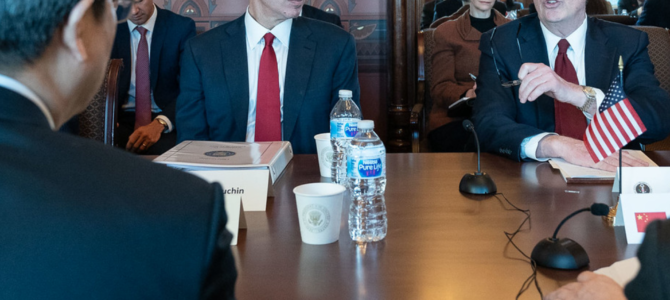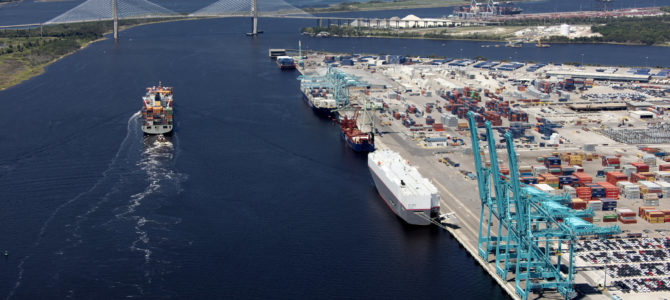
Last Friday, U.S. and Chinese officials confirmed that that two nations reached a “phase one” trade deal. After more than two years of uncertainty, this is welcome news for many. Yet it is concerning because so few details of the agreement have been made public, and a deal-signing date has yet to be announced.
What’s in the Trade Deal?
According to the Wall Street Journal, the United States agreed not to impose new tariffs on $156 billion in consumer goods, including smartphones and toys, that were going to take effect Dec. 15. The United States will also cut the tariffs on $120 billion in Chinese imports imposed in September from 15 percent to 7.5 percent. But the United States will maintain the 25 percent tariffs on a separate $250 billion in Chinese imports for now as an incentive for China to engage in phase two trade talks.
While the U.S. commitment is straightforward, what the Chinese have agreed to do is vague. The same WSJ report says China has agreed to increase its purchase of U.S. agricultural and other goods, but by how much is unclear. U.S. Trade Representative Robert Lighthizer said China would increase its imports of U.S. agriculture produce to about $40-$50 billion over two years. But experts immediately pointed out that before the trade war began, China imported $20 billion worth of U.S. farm products in 2017.
Is it realistic to expect China to double its imports in two years? Even if China manages to do so for sheer political reasons and put excess purchases in storage, what will happen in year three? Is the $40-$50 billion annual target sustainable? Also, U.S. worldwide agricultural exports were about $112 billion in 2017 and remained unchanged in 2019 despite the trade war with China. So a drastic increases of U.S. agricultural imports from China may not represent an increase of new demand but a reallocation of existing demand, which may not mean as much for U.S. farmers.
Besides increased imports, China supposedly made commitments on intellectual property, including “counterfeiting, patent and trademark issues and pharmaceutical rights, as well as on preventing the forced transfer of technology from firms entering the Chinese market.” However, those commitments include no details, not even in the statement from the U.S. trade representative’s office.
Chinese officials confirmed that the text of the agreement covers topics including intellectual property rights, technology transfers, food and agricultural products, and dispute settlement. However, they only emphasized that the United States would remove a number of tariffs without mentioning any commitments China had made, not even giving any specific dollar amount on the additional U.S. farm products purchases.
Chinese officials insisted, “China will not sacrifice the interests of its other trade partners to fulfill the demands of the U.S.,” and, “Any agricultural products purchase made by China will be based on our own demands.” Such attitude and language from Chinese officials raises questions on how effective this limited trade agreement will be.
Even Lighthizer acknowledged Sunday on CBS’ “Face the Nation” that whetherthis phase one deal will work depends on “who’s making the decisions in China, not in the United States. If the hard-liners are making the decisions, we’re going to get one outcome. If the reformers are making the decisions, which is what we hope, then we’re going to get another outcome.”
Will History Repeat Itself?
We’ve been down this road with China many times before. Tough words on paper have failed to push China to change its behavior. In 1992, the United States and China reached a bilateral agreement, in which Beijing agreed to new measures to protect intellectual property (IP) and even added new IP protection laws to its books. The U.S. side proclaimed, “The commitments that China made [to IP protection] greatly exceeded any assurances that had been offered in our prior bilateral negotiations.” At the time, the United States had lost an estimated $225 million in software sales in 1991 through piracy.
What happened next? Nothing, except the IP theft has gotten worse. The South China Morning Post reports, “In 1994, the Office of the United States Trade Representative identified 29 factories, most in southern China, that were producing pirated software, music and video CDs. They helpfully gave their Chinese counterparts the addresses. The following year, the number of factories had grown to 34.”
In 1995, the U.S. and China negotiated a new deal that included mechanisms to ensure China would enforce its IP protection law. The U.S. chief negotiator, Charlene Barshefsky, said of the new agreement, “This is the single most comprehensive and detailed [IP rights] enforcement agreement the U.S. has ever concluded. The U.S. is very pleased.” By 2015, the U.S. Commission on the Theft of American Intellectual Property estimated that U.S. losses from IP theft were in the range of US$180 billion to US$540 billion, with most of those attributed to China.
This latest phase one trade deal does include a dispute resolution process, which will allow companies to bring up any complaints with officials at the U.S. Trade Representative’s Office or even higher-level officials if unresolved. Again, whether this process will work as designed is all up to how committed China will be. Let’s hope history doesn’t repeat itself.
The Limited Deal Leaves Many Strategic Goals Unresolved
Since the phase one deal is a limited trade deal, it has left many thorny issues unresolved, including China’s cyber theft and political interference, the Chinese government’s massive subsidies to its state-owned enterprises, and the timing and likelihood of opening up closed sectors to foreign investments. It’s worth pointing out that the United States and China’s trade war isn’t about trade alone. If it were solely about the trade deficit and the United States’ desire to sell more material goods to China, the trade dispute would have been resolved a long time ago.
The trade war Trump initiated was meant to have China agree to a new set of rules of engagement, which will force China to abide by established international rules and regulations and engage the United States in a fair and balanced manner. A limited deal like the one we have now is inadequate to address the goals the United States wants to achieve strategically, such as how to counter China’s increasing industrial espionage activities in the United States.
As if we need a reminder, at the beginning of this month, China announced it would retaliate against the United States over the Hong Kong human rights bill by denying the U.S. Navy’s port visits to Hong Kong and sanctioning a number of U.S.-based non-governmental organizations (NGOs) including Human Rights Watch.
The New York Times reported Sunday that the U.S. government expelled two Chinese diplomats this fall after they drove to a sensitive military base in Virginia. The expulsion was the first of this kind in more than 30 years. The Times also quoted an American official who pointed out that “Chinese officials with diplomatic passports have become bolder about showing up unannounced at research or government facilities.”
These incidents confirm that a phase one deal at best represents only a temporary truce between the two countries in the trade dispute. It doesn’t change or even slow down the strategic competition and confrontation of the two nations. The two countries have such different economic and political systems and, more importantly, different sets of values that we may have to settle our differences through other means, beyond a trade agreement.









